Sand soil, clay soil, and loam soil have the following two physical properties:
1. Drainage
2. Capillarity
Let’s discuss this in further detail.
This refers to the ability of the soil to let water pass through it.
When soil allows too much water to pass through it we say the soil is POROUS.
Drainage could also mean the ability of soil to hold water or retain water.
When soil holds water it means that the soil does not allow too much water to pass through it.
This refers to how well water rises up in the soil.
Capillarity can be measured by the speed at which water rises in the soil and the extent to which the water rises.
Capillarity depends on the size of the spaces between soil particles.
The smaller the spaces, the higher the water rises in the soil.
This means that clay soil allows water to rise highest compared to Sand soil and Loam soil.
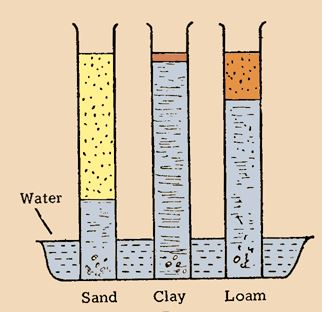
Water tends to rise very fast in sand soil but after a while, it slows down.
The water does not rise so high.
Clay soil allows water to rise slowly but higher.
Capillarity helps in making groundwater rise above the ground surface.
The following set up can be used to determine a sample soil's drainage:

An illustration of drainage in different soils.
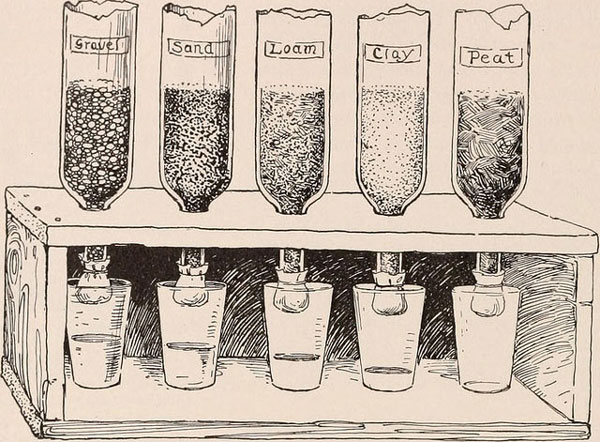
These are 5 inverted cut bottles with different soils:
(Gravel, Sand, Loam, Clay, and Peat)
- The piece of cloth is tied at the mouth of the bottle to let out water at the same rate as the piece of cotton wool in the previous diagram.
- Soil that is very porous holds very little water and therefore allows too much water to pass through it.
- From the above, gravel has very large particles,it allows too much water to pass through it meaning it holds little water.
- Peat has more fine particles than Clay Soil, hence holds more water than Clay. It therefore allows very little water to pass through it.
Use the following information to answer questions 1 and 2
Standard VII pupils put equal amounts of different types of soil P, Q, R and S into four identical tins. Each tin had a hole at the bottom. They then poured equal amounts of water into each tin. All the water that passed through the holes was collected into identical containers as shown in the diagrams below.
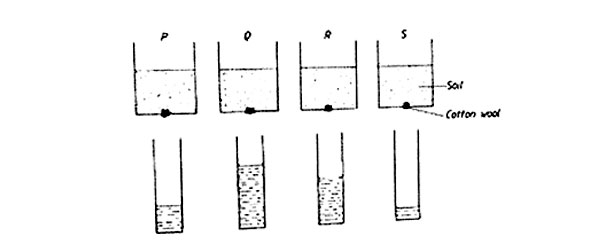
1. Which one of the following statements is correct?
A. Soil Q retained more water than soil R
B. Soil S retained the smallest amount of water
C. Soil Q retained the smallest amount of water
D. Soil P retained less water than soil Q
2. From the experiment above, soil R is likely to be
A. Sand B. Clay C. Loam D. Mixture of sand and loam
3. Some pupils from Mchanga primary school set up apparatus shown in the diagram below.
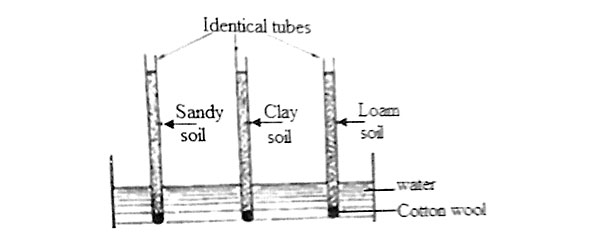
They then measured the rise of water in each type of soil after every 10 minutes and plotted their results as shown in the graphs below.
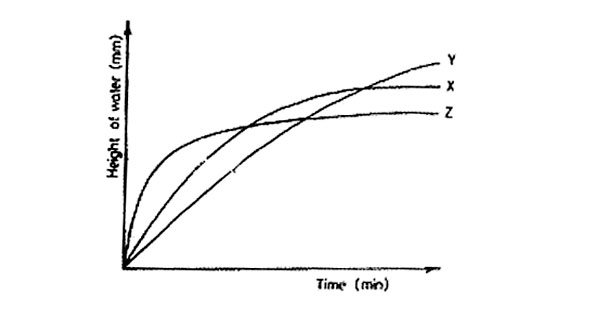
The soil types represented by the graphs X, Y and Z are most likely to be
|
X |
Y |
Z |
| Loam |
Sandy |
Clay |
| Sandy |
Clay |
Loam |
| Loam |
Clay |
Sandy |
| Sandy |
Loam |
Clay |
4. Kichungi wanted to filter some muddy water. She poured it into a filter which was arranged as shown in the diagram below.
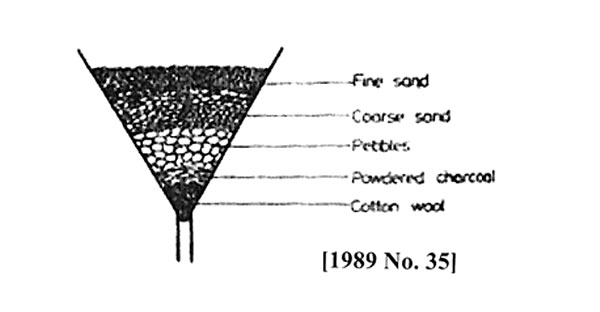
The main purpose of the charcoal in this filter was to
A. Remove any floating leaves
B. Absorb dust particles C. Remove germs D. Absorb colour
5. The table below contains some information about three types of soils X, Y and Z collected by a group of pupils.
|
Soil type |
Particle size |
Feel when wet |
Colour |
|
X |
Small |
Smooth and sticky |
Greyish-black |
|
Y |
Large |
Rough and not sticky |
Light brown |
|
Z |
Medium |
Smooth and not sticky |
Dark brown |
The three types of soil are most likely to be
|
X |
Y |
Z |
| A. Clay |
Loam |
Sandy |
| B. Loam |
Sandy |
Clay |
| C. Loam |
Clay |
Sandy |
| D. Clay |
Sandy |
Loam |
6. Which one of the following statements about air in soils is CORRECT?
A. Loam soil contains more air between its particles than sandy soil
B. Clay soil has the highest amount of air between its particles
C. Sandy soil has the highest amount of air between its particles
D. Loam soil contains less air between its particles than clay soil
7. Pupils investigating how fast water passes through different types of soils, set up an experiment as shown below.
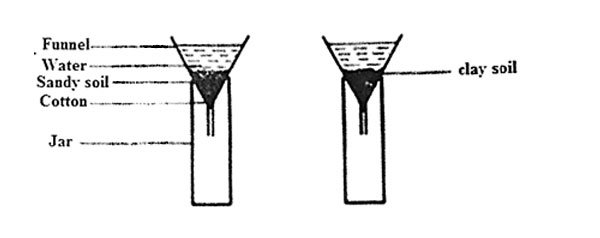
Which of the following is LEAST important for this experiment?
A. Using the same amount of each soil
B. Using the same size of funnel in each case
C. Pouring the same amount of water to each funnel
D. Using the same size of jars in each case
8. An experiment was set up to investigate capillarity in different soils as shown in the diagram below.

In which tube would the water rise the highest if the set up was left to stand for 12 hours?
A. I B. II C. III D. IV
9. Which one of the following properties of soil does NOT depend o the size of its particles?
A. Colour B. Water retention C. Drainage D. Texture
10. Equal amounts of different types of soils J, K, L, and M were put into four identical glass containers. Equal volumes of water were then added to each container. After air had escaped from the soil in each container, the levels of water in the containers were as shown in the diagrams below.
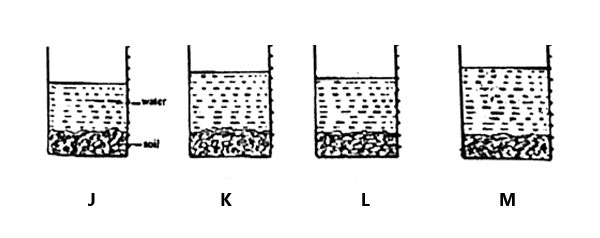
Which one of the following conclusions about soils is correct?
A. Soil L had more air spaces between its particles than soil K
B. Soil M had the most air spaces between its particles
C. Soil K had less air space between its particles than soil M
D. Soil J had the least air spaces between particles
11. An experiment was set up as shown in the diagrams below
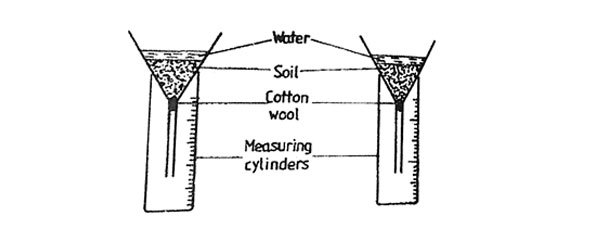 The experiment was to investigate
The experiment was to investigate
A. Water retention by different types of soil
B. Capillarity in different types of soil
C. Amount of air in different types of soil
D. Amount of humus in different types of soil
12. The set-ups in the diagram below were used to investigate how water moves up in different types of soil.
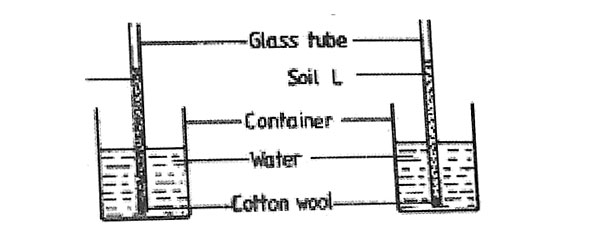
Which one of the following need NOT be the same in both set-ups?
A. Size of containers B. Size of glass tubes
C. Amount of cotton wool in each glass tube
D. Amount of soil in each glass tube
13. Standard V pupils collected different types of soils from their home areas for experiments. One of the soil samples was found to have the following characteristics.
i) Has very fine soil particles
ii) Retains more water than all the others
iii) Makes thinner and longer ribbons than all the others
Which one of the following types of soil has the characteristics listed above?
A. Clay soil B. Loam soil C. Sandy soil D. Sandy loam
14. In which of the following types of soil does water drain FASTEST?
A. Loam B. Clay C. Sand D. Mixture of clay and loam
15. How can water retention ability of sandy soil be improved?
A. By practicing crop rotation B. By growing cover crops
C. By constructing terraces C. By applying organic manure
16. Some pupils wanted to male ribbons using different mixtures of soil and water. From which mixture would they find it MOST DIFFICULT to make long ribbons?
A. Sand and clay B. Clay and loam
C. Clay, sand and loam D. Sand and loam
17. The set up shown in the diagrams below was used to compare the amount of air present in different types of soil.

Which one of the following need NOT be the same?
A. Size of soil particles B. Size of a glass container
C. Amount of soil in each glass container
D. Amount of water in each glass container
18. Which type of soil MOST difficult to cultivate when wet?
A. Sandy soil B. Clay soil C. Loam soil D. Sandy loam soil
19. A group of pupils set up an experiment in which they added equal amounts of water to soil samples I, II and III. Their results are shown in the diagrams below.

From the results, soil samples I, II and III are most likely to be
|
I |
II |
III |
| A. Clay |
Loam |
Sand |
| B. Loam |
Clay |
Sand |
| C. Sand |
Clay |
Loam |
| D. Loam |
Sand |
Clay |
20. Fatuma and Mwadime wanted to find out the soil sample that retains more water. They added equal amounts of water to clay and sand. The set up was as shown in the diagram below.
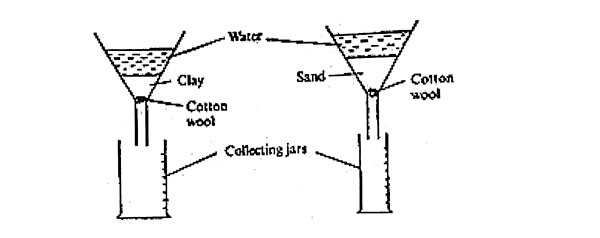
What mistake did the pupils make in setting up the experiment?
A. Using collecting jars of different sizes.
B. Adding equal amounts of soil
C. Using different amounts of soil D. Using similar funnels
21. Which one of the following types of soil is suitable for z site for constructing a fish pond?
A. Sandy soil B. Loam soil C. Sandy loam soil D. Clay soil
22. The diagrams below show amounts of water that drained through equal samples of soils. Which one drained through a sample obtained from an anthill?

23. Which one of the following is NOT needed in an experiment to determine capillarity in different soils?
A. Biro pen casing B. Piece of cloth C. Basin D. Measuring cylinder
24. Which one of the following types of soil has the highest water holding capacity?
A. Clay soil B. Loam soil C. Sandy loam soil D. Sandy soil
25. Equal samples of soil were obtained from a garden, forest, playfield, and dry river bed. They were heated thoroughly for the same length of time.
The sample of soil MOST LIKELY to have lost the greatest mass was that obtained from the
A. Garden B. Forest C. Playfield D. Dry river bed
26. Equals amounts of clay, loam, and sand were mixed. The mixture was placed in a transparent bottle, then water was added. The contents were shaken and allowed to settle. The MOST LIKELY arrangement of the layers of soil sample would be
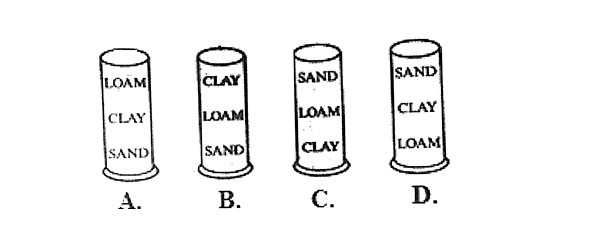
27. Which one of the following types of soil has the highest percentage of large soil particles?
A. Clay soil B. Loamy soil C. Sandy soil D. Sandy loam soil